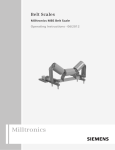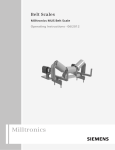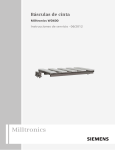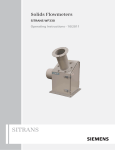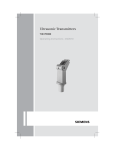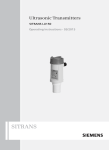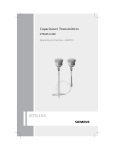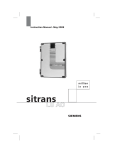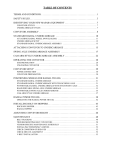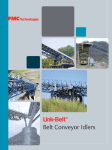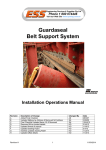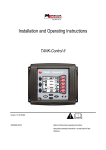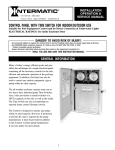Download Milltronics MLC - Lesman Instrument Company
Transcript
Belt Scales Milltronics MLC Belt Scale Operating Instructions 06/2012 Milltronics Safety Guidelines Warning notices must be observed to ensure personal safety as well as that of others, and to protect the product and the connected equipment. These warning notices are accompanied by a clarification of the level of caution to be observed. Qualified Personnel This device/system may only be set up and operated in conjunction with this manual. Qualified personnel are only authorized to install and operate this equipment in accordance with established safety practices and standards. Unit Repair and Excluded Liability: The user is responsible for all changes and repairs made to the device by the user or the user’s agent. All new components are to be provided by Siemens Milltronics Process Instruments. Restrict repair to faulty components only. Do not reuse faulty components. Warning: Cardboard shipping package provides limited humidity and moisture protection. This product can only function properly and safely if it is correctly transported, stored, installed, set up, operated, and maintained. This product is intended for use in industrial areas. Operation of this equipment in a residential area may cause interference to several frequency based communications. Note: Always use product in accordance with specifications. Copyright Siemens AG 2012. All Rights Reserved Disclaimer of Liability This document is available in bound version and in electronic version. We encourage users to purchase authorized bound manuals, or to view electronic versions as designed and authored by Siemens Milltronics Process Instruments. Siemens Milltronics Process Instruments will not be responsible for the contents of partial or whole reproductions of either bound or electronic versions. While we have verified the contents of this manual for agreement with the instrumentation described, variations remain possible. Thus we cannot guarantee full agreement. The contents of this manual are regularly reviewed and corrections are included in subsequent editions. We welcome all suggestions for improvement. Technical data subject to change. MILLTRONICS®is a registered trademark of Siemens Milltronics Process Instruments. Contact SMPI Technical Publications at the following address: European Authorized Representative Technical Publications Siemens AG Siemens Milltronics Process Instruments 1954 Technology Drive, P.O. Box 4225 Peterborough, Ontario, Canada, K9J 7B1 Email: [email protected] Siemens AG Industry Sector 76181 Karlsruhe Deutschland For a selection of Siemens Milltronics level measurement manuals, go to: www. siemens.com/processautomation. Under Process Instrumentation, select Level Measurement and then go to the manual archive listed under the product family. For a selection of Siemens Milltronics weighing manuals, go to: www. siemens.com/processautomation. Under Weighing Technology, select Continuous Weighing Systems and then go to the manual archive listed under the product family. © Siemens AG 2012 Milltronics MLC 1 ___________________ Introduction 2 ___________________ Safety notes Milltronics Belt Scales Milltronics MLC 3 ___________________ Description 4 ___________________ Installing/Mounting 5 ___________________ Connecting 6 ___________________ Commissioning Operating Instructions 7 ___________________ Service and maintenance 8 ___________________ Technical data 9 ___________________ Dimension drawings 06/2012 7ML19985FF01-01 Legal information Legal information Warning notice system This manual contains notices you have to observe in order to ensure your personal safety, as well as to prevent damage to property. The notices referring to your personal safety are highlighted in the manual by a safety alert symbol, notices referring only to property damage have no safety alert symbol. These notices shown below are graded according to the degree of danger. DANGER indicates that death or severe personal injury will result if proper precautions are not taken. WARNING indicates that death or severe personal injury may result if proper precautions are not taken. CAUTION with a safety alert symbol, indicates that minor personal injury can result if proper precautions are not taken. CAUTION without a safety alert symbol, indicates that property damage can result if proper precautions are not taken. NOTICE indicates that an unintended result or situation can occur if the relevant information is not taken into account. If more than one degree of danger is present, the warning notice representing the highest degree of danger will be used. A notice warning of injury to persons with a safety alert symbol may also include a warning relating to property damage. Qualified Personnel The product/system described in this documentation may be operated only by personnel qualified for the specific task in accordance with the relevant documentation, in particular its warning notices and safety instructions. Qualified personnel are those who, based on their training and experience, are capable of identifying risks and avoiding potential hazards when working with these products/systems. Proper use of Siemens products Note the following: WARNING Siemens products may only be used for the applications described in the catalog and in the relevant technical documentation. If products and components from other manufacturers are used, these must be recommended or approved by Siemens. Proper transport, storage, installation, assembly, commissioning, operation and maintenance are required to ensure that the products operate safely and without any problems. The permissible ambient conditions must be complied with. The information in the relevant documentation must be observed. Trademarks All names identified by ® are registered trademarks of Siemens AG. The remaining trademarks in this publication may be trademarks whose use by third parties for their own purposes could violate the rights of the owner. Disclaimer of Liability We have reviewed the contents of this publication to ensure consistency with the hardware and software described. Since variance cannot be precluded entirely, we cannot guarantee full consistency. However, the information in this publication is reviewed regularly and any necessary corrections are included in subsequent editions. Siemens AG Industry Sector Postfach 48 48 90026 NÜRNBERG GERMANY Order number: 7ML19985FF01 Ⓟ 06/2012 Technical data subject to change Copyright © Siemens AG 2012. All rights reserved Table of contents 1 Introduction................................................................................................................................................ 5 1.1 2 Safety notes............................................................................................................................................... 7 2.1 3 4 5 The manual ....................................................................................................................................5 General safety instructions ............................................................................................................7 Description................................................................................................................................................. 9 3.1 Introduction ....................................................................................................................................9 3.2 Principle of operation ...................................................................................................................10 Installing/Mounting................................................................................................................................... 11 4.1 Introduction ..................................................................................................................................11 4.2 4.2.1 4.2.2 4.2.3 4.2.4 4.2.5 4.2.6 4.2.7 4.2.8 Conveyor considerations .............................................................................................................11 Control gates................................................................................................................................12 Conveyor belting ..........................................................................................................................12 Head pulley ..................................................................................................................................12 Conveyor curvature......................................................................................................................15 Belt ploughs .................................................................................................................................16 Stacker conveyors .......................................................................................................................16 Conveyor trippers.........................................................................................................................16 Skirt boards and sealing strips.....................................................................................................17 4.3 Load cell handling ........................................................................................................................17 4.4 Installation precautions ................................................................................................................18 4.5 Installation procedures.................................................................................................................19 4.6 Idler alignment..............................................................................................................................20 4.7 Idler alignment procedure ............................................................................................................21 Connecting .............................................................................................................................................. 25 5.1 Belt scale wiring ...........................................................................................................................25 Milltronics MLC Operating Instructions, 06/2012, 7ML19985FF01-01 3 Table of contents 6 7 8 Commissioning ........................................................................................................................................ 27 6.1 Calibration ................................................................................................................................... 27 6.2 Test load...................................................................................................................................... 27 6.3 Balancing..................................................................................................................................... 28 6.4 Final calibration ........................................................................................................................... 28 6.5 Zero calibration ........................................................................................................................... 28 6.6 Span calibration .......................................................................................................................... 29 6.7 Material test................................................................................................................................. 29 6.8 Re-rating...................................................................................................................................... 29 Service and maintenance ........................................................................................................................ 31 7.1 Maintenance................................................................................................................................ 31 7.2 Replacing a load cell ................................................................................................................... 32 7.3 Spare parts.................................................................................................................................. 32 7.4 Technical support........................................................................................................................ 33 Technical data ......................................................................................................................................... 35 8.1 9 Specifications .............................................................................................................................. 35 Dimension drawings ................................................................................................................................ 39 9.1 Outline dimensions...................................................................................................................... 39 Milltronics MLC 4 Operating Instructions, 06/2012, 7ML19985FF01-01 Introduction 1 Note The Siemens weighing system is to be used only in the manner outlined in this manual, otherwise protection provided by equipment may be impaired. It is your responsibility to read this manual before installing and starting up any component of the weighing system to which the belt scale is being applied. 1.1 The manual This manual covers only belt scale installation, operation, and maintenance procedures. Integrator and speed sensor operating instructions are available for download from our website: Siemens weighing (http://www.siemens.com/weighing) Follow these operating instructions for quick, trouble-free installation, and maximum accuracy and reliability of your weighing system. We always welcome suggestions and comments about manual content, design, and accessibility. Please direct your comments to: Technical publications (mailto:[email protected]) Milltronics MLC Operating Instructions, 06/2012, 7ML19985FF01-01 5 Introduction 1.1 The manual Milltronics MLC 6 Operating Instructions, 06/2012, 7ML19985FF01-01 2 Safety notes 2.1 General safety instructions CAUTION Correct, reliable operation of the product requires proper transport, storage, positioning and assembly as well as careful operation and maintenance. Only qualified personnel should install or operate this instrument. Note Alterations to the product, including opening or improper repairs of the product, are not permitted. If this requirement is not observed, the CE mark and the manufacturer's warranty will expire. Milltronics MLC Operating Instructions, 06/2012, 7ML19985FF01-01 7 Safety notes 2.1 General safety instructions Milltronics MLC 8 Operating Instructions, 06/2012, 7ML19985FF01-01 Description 3.1 3 Introduction Milltronics MLC belt scale is a low-capacity scale for light belt loading. It is designed to be inserted into either a flat roll idler (non-troughing) belt conveyor or a flat pan slider belt conveyor for continuous weighing of dry bulk solids. The MLC is suitable for monitoring such products as fertilizer, tobacco, animal feed pellets, and sugar. System components The MLC belt scale consists of the following: ● one weighbridge with two load cells and an idler, and ● a Siemens test weight, ordered separately. The MLC load cells output an electrical signal proportional to load, which is applied to the selected Siemens belt scale integrator. Thus, weighing is accomplished without interrupting the process and without affecting the process. To limit the weight and dimensions of the idler on the scale, Siemens provides an idler built to definite specifications as part of the scale. If a substitute or a replacement is required, please contact Siemens. Substituting or replacing this idler with a non-specific idler could result in damage to the scale due to overloading or improper fit. Note The MLC belt scale is an accurate and repeatable force sensor. Its performance is ultimately dependent upon the conveyor system and the quality of the installation and accuracy of the alignment. Milltronics MLC Operating Instructions, 06/2012, 7ML19985FF01-01 9 Description 3.2 Principle of operation 3.2 Principle of operation Belt scales work with an existing belt conveyor and the selected Siemens integrator. As material moving along the conveyor belt travels over the belt scale, it exerts a force proportional to the material load through the suspended idler to the load cells. The belt scale reacts only to the vertical component of the applied force. The resulting movement in each load cell is sensed by its strain gauges. When the strain gauges are excited by voltage from the electronic integrator, they produce an electrical signal proportional to weight, which is then returned to the integrator. The vertical movement of the load cells is limited by the positive overload stop incorporated into the design of the belt scale. Milltronics MLC 10 Operating Instructions, 06/2012, 7ML19985FF01-01 Installing/Mounting 4.1 4 Introduction CAUTION Installation shall be performed only by qualified personnel in accordance with local governing regulations. The belt scale is shipped from the factory as a single unit packed in a container for protection. The weigh module must be removed from its package and inspected for physical damage. Be sure the conveyor design meets the installation requirements for the belt scale. Note Use only approved conduit and conduit fittings or cable glands to maintain NEMA or IP rating, as applicable. Adjust conveyor stringers to be rigid, straight, parallel to, and square with the belt line in the area of the scale installation. Adjust pulleys to ensure that the conveyor belt tracks straight and centrally from the head to the tail pulley. The idler to be used on the scale and at least the next two approach and retreat idlers, must be of the same style and manufacturer, and in good condition. Prepare the site in accordance with the Siemens drawing(s) or by referring to the Belt Scale Applications Guidelines (7ML19985GA01). 4.2 Conveyor considerations The ideal placement of the belt scale depends on the conveyor system. This section provides guidelines to determine belt scale placement. Milltronics MLC Operating Instructions, 06/2012, 7ML19985FF01-01 11 Installing/Mounting 4.2 Conveyor considerations 4.2.1 Control gates The installation of a material feed control gate or similar device improves uniform flow of material. ① ② ③ Control gate Uniform material distribution Belt scale Note Ensure steady and uniform material loading to the belt at or near the same speed as the conveyor belt. 4.2.2 Conveyor belting Variations in the number of belt plies, the cover thickness and the type and number of splices in a given belt cause considerable change in the weight per unit length of the belt. During the course of zero calibrations, belt scales average the weight of the belt over one complete circuit of the belt. Large deviations from the average adversely affect the zero calibrations. 4.2.3 Head pulley Note Use caution when installing a scale in a short conveyor, or when locating the scale near the head pulley. Since head pulleys are flat faced, and carrying idlers are generally troughed, the belt profile must change from troughed to flat in a short distance. To accommodate this, the conveyor manufacturer designs a built-in vertical displacement of the head pulley above the top of the center roll of the adjacent idler. Milltronics MLC 12 Operating Instructions, 06/2012, 7ML19985FF01-01 Installing/Mounting 4.2 Conveyor considerations ● Insert idlers of decreasing trough angles between the head pulley and the normal run of idlers or there will be a considerable amount of stress on the belt edges and the idlers adjacent to the head pulley. The stress is transmitted to the scale. Note On conveyors with 20° trough idlers throughout, a minimum of two fixed 20° idlers must be located between the scale idler and the head pulley. ① ② ③ ④ 20º idlers Minimum 3 idler spaces Head pulley Belt scale Note On conveyors with 35° trough idlers throughout, a minimum of two 35° and one 20° retreat idlers must be located between the scale and the head pulley. ① ② ③ ④ ⑤ ⑥ 35º idlers Minimum 4 idler spaces Head pulley 20º idler 35º idlers Belt scale Note On conveyors with 45° trough idlers throughout, a minimum of two 45°, one 35°, and one 20° retreat idlers must be located between the scale and the head pulley. Milltronics MLC Operating Instructions, 06/2012, 7ML19985FF01-01 13 Installing/Mounting 4.2 Conveyor considerations 7 ① ② ③ ④ ⑤ ⑥ ⑦ 45º idlers Minimum 5 idler spaces Head pulley 20º idler 35º idler 45º idlers Belt scale Note The vertical displacement of the head pulley relative to the adjacent retreat idler is normally in excess of that which is acceptable for belt scale installations. When locating the scale close to the head pulley, a maximum of 13 mm (½") vertical displacement between the top of the head pulley and the top of the center of the adjacent roll is allowed. ① ② ③ 13 mm (1/2") maximum Head pulley 20° idler, center roll Milltronics MLC 14 Operating Instructions, 06/2012, 7ML19985FF01-01 Installing/Mounting 4.2 Conveyor considerations 4.2.4 Conveyor curvature Vertical curvature (varied heights on one belt) is common in conveyor design, but creates difficulties for belt scales if not dealt with correctly. The curvature, whether concave (internal) or convex (external), disturbs the idler alignment, if the scale is installed in the area of curvature. The concave curve tends to lift the belt off of the idlers in the area of curvature as belt loading decreases, adversely affecting the zero calibration. Note Avoid locating the scale within the tangents of scale curvature. Concave ① ② ③ Minimum 12 m (40 ft) Tangents Belt scale Convex ① ② ③ ④ Minimum 6 m (20 ft) Minimum 12 m (40 ft) Tangents Belt scale Milltronics MLC Operating Instructions, 06/2012, 7ML19985FF01-01 15 Installing/Mounting 4.2 Conveyor considerations 4.2.5 Belt ploughs Belt ploughs or any conveyor or material control device that changes the profile of the carrying belt in or near the scale area is not recommended. These devices can negatively affect the belt scale idler alignment and usually create drag on the belt which the scale senses as a material force of load. Note Do not install the scale within 9 m (30 ft) of belt ploughs or similar devices that contact the material or belt. 4.2.6 Stacker conveyors Any conveyor that is not a permanent structure, which varies in its incline, elevation or profile is not considered a good installation for an accurate belt scale. A belt scale can be used effectively in this conveyor type, but requires special setup. Siemens offers an inclinometer for use with variable incline conveyors. 4.2.7 Conveyor trippers Note On a conveyor with a tripper car, locate the scale under the recommendations for vertical curves, but with the tripper fully retracted. Milltronics MLC 16 Operating Instructions, 06/2012, 7ML19985FF01-01 Installing/Mounting 4.3 Load cell handling 4.2.8 Skirt boards and sealing strips Sometimes it is necessary to extend the infeed skirt boards and sealing strips the full length of the conveyor. This can create problems in weighing accuracy if the sealing strips exert excess force when contacting the belt and indirectly upon the idlers, especially where pinching occurs. The situation adversely affects the zero calibrations. ① ② ③ ④ Skirt board Sealing strip dragging along belt Pinching can occur here Idler Note If possible, remove skirting in scale area. If not, adjust skirting so sealing strip does not put excess force on the belt or allow pinching of material. 4.3 Load cell handling The MLC belt scale is designed for low-capacity operation and is constructed using two 10 or 20 pound load cells. Although the load cells are protected by shipping stops that keep the cells from moving, care should be taken when handling the scale to avoid damaging the cells. The stops are metal strips about 75 mm (3") long with holes at each end for screws. One screw holds the stop to the load cell while the other screw holds the stop to the static beam [25 mm (5") channel]. When handling the MLC during installation and setup, make sure the stops remain in place. Reinstall both shipping stops during maintenance or prolonged shutdown. Milltronics MLC Operating Instructions, 06/2012, 7ML19985FF01-01 17 Installing/Mounting 4.4 Installation precautions 4.4 Installation precautions The following precautions should be observed when handling the scale. ● Do not pry on the idler, its mountings, or the cells directly. ● Do not stand or lean on the scale. ● Avoid shock from blows of a hammer when trying to position the scale during installation. ● Do not lift the scale by its idler. ● Do not lift the scale by the idler mounting brackets. Note For general safety and best system performance, the belt scale must be grounded through the conveyor and the conveyor must be grounded to earth. CAUTION Arc welding Use extreme caution when arc welding in the area of the belt scale. Ensure that no welding current can flow through the belt scale. Welding currents passing through the scale can functionally damage the load cells. Milltronics MLC 18 Operating Instructions, 06/2012, 7ML19985FF01-01 Installing/Mounting 4.5 Installation procedures 4.5 Installation procedures 1. Remove the existing flat roll idler (or flat slider pan) from the area selected to locate the belt scale assembly. 2. Drill four 12 mm (7/16") diameter mounting holes. This will allow clearance for 10 mm (3/8") bolts. ① 12 mm (7/16"), four places Note Slotting the holes vertically will permit greater adjustment capability. 3. Position the scale with the idler towards the head end of the conveyor (discharge) and the static beam toward the tail end (infeed). – Make sure the belt travel sticker on the static beam points in the direction of belt travel. – Raise the conveyor belting to provide room for the installation of the scale. 4. Insert the scale (complete with the attached idler) into the conveyor. – Insert four 10 mm (3/8") bolts through the conveyor frame and through the holes in the ends of the static beam. – Secure with hex nuts. Finger tight only. 5. Make sure there is at least 13 mm (1/2") of clearance between the return belt and the MLC. – In some conveyors, it may be necessary to install a return idler roller adjacent to the scale to deflect the return belt past the scale. 6. Position the scale so that it is centered in the conveyor and square to the stringer. – Shim as required between the ends of the static beam and the conveyor stringer. – Level the static beam and tighten the bolts sufficiently to keep the static beam in place until final adjustment. Milltronics MLC Operating Instructions, 06/2012, 7ML19985FF01-01 19 Installing/Mounting 4.6 Idler alignment CAUTION Off-center or off-square installation can result in poor belt tracking and scale inaccuracy. 4.6 Idler alignment Precise alignment is very important to achieve maximum accuracy of the weighing system. Improperly aligned idlers could cause unwanted forces to be applied to the weighing idler, resulting in measurement errors. Milltronics MLC 20 Operating Instructions, 06/2012, 7ML19985FF01-01 Installing/Mounting 4.7 Idler alignment procedure 4.7 Idler alignment procedure 1. Position the scale so that it is centered and square to the stringer. ① ② 25 mm TYP. (1") (both sides) Aligning wire (customer supplied) 2. Release the shipping stops in order to free the weighing mechanism. Loosen screws 'B' and remove screws 'A', then rotate both shipping stops inward. Tighten screws 'B' to secure in place. ① ② ③ Screws 'A' Shipping stops Screws 'B' Milltronics MLC Operating Instructions, 06/2012, 7ML19985FF01-01 21 Installing/Mounting 4.7 Idler alignment procedure ① ② ③ ④ MLC belt scale This idler supplied by Siemens. 25 mm TYP. (1") (both sides) Aligning wire 0.5 mm dia. (0.020") or equivalent (customer supplied) Note Keep the stops and screws stored in a convenient place for use during maintenance or at other times when protection of the cells is necessary. Milltronics MLC 22 Operating Instructions, 06/2012, 7ML19985FF01-01 Installing/Mounting 4.7 Idler alignment procedure 3. Align and level the idler in the weighing area by raising or lowering the static beam in its mountings. – The weighing area includes the scale and at least one idler on each side of the scale. For conventional flat idler roll conveyors, two additional idler rolls should be included in the alignment procedure. 4. Adjust idlers (idlers and pans on a slider pan conveyor) vertically until they are all within ±0.8 mm (1/32") of each other. – Stretch a line across the top surface of each idler roll in the scale area at approximately 25 mm (1") from each end of each idler roll. – Use good quality wire [0.5 mm (0.020") diameter] or equivalent nylon line to check for alignment. The wire or string aligning lines must be able to withstand sufficient tension to eliminate sag in the line. 5. Check that the idlers are centered and squared to the conveyor as in step 5 of the installation procedure. 6. Tighten the static beam mounting bolts (34 to 40.8 Nm or 25 to 30 ft lbs). 7. Carefully lower the conveyor belt onto the scale and fixed idlers. 8. Run the conveyor for at least fifteen minutes to limber the belt prior to calibration. Milltronics MLC Operating Instructions, 06/2012, 7ML19985FF01-01 23 Installing/Mounting 4.7 Idler alignment procedure Milltronics MLC 24 Operating Instructions, 06/2012, 7ML19985FF01-01 5 Connecting 5.1 Belt scale wiring ① Load cells, complete with 3 m (10 ft) cable in flexible conduit with 1/2" NPT panel connector Load cell A B ② ③ Load cell 'B' Load cell 'A' MLC Milltronics Integrator SIWAREX FTC RED + EXC + EXC BLK - EXC - EXC WHT - SIG 'A' - SIG GRN + SIG 'A' + SIG SHIELD SHIELD SHIELD RED + EXC + EXC BLK - EXC - EXC WHT - SIG 'B' - SIG GRN + SIG 'B' + SIG SHIELD SHIELD SHIELD Note To avoid affecting the weighing process, do not support conduit or load cell cables on the weighing idler, or on the idler support components of the belt scale. Milltronics MLC Operating Instructions, 06/2012, 7ML19985FF01-01 25 Connecting 5.1 Belt scale wiring Milltronics MLC 26 Operating Instructions, 06/2012, 7ML19985FF01-01 6 Commissioning 6.1 Calibration After all parts of the weighing system (belt scale, speed sensor, integrator) have been properly installed and connected, the weighing system and integrator must be calibrated. The calibration is initially done using the test weight(s), however material tests are recommended to achieve the greatest accuracy. Refer to the integrator operating instructions for programming and calibration details and for information about material tests. All operating instructions are available for download at our web site: Siemens weighing (http://www.siemens.com/weighing) 6.2 Test load The test load value is required for calibration of the integrator. Enter the calculated value into the associated programming parameter of the integrator in kilograms per meter or pounds per foot. The test load value is calculated as follows: Test load = test weight mass kg or idler spacing m lb ft where idler spacing = L/2 [minimum 0.6 m (2.0')] $ $ 6 5 5 ① Dimension L Milltronics MLC Operating Instructions, 06/2012, 7ML19985FF01-01 27 Commissioning 6.3 Balancing 6.3 Balancing For applications where the conveyor loading does not repeat in locations across the width of the belt, such as side-to-side loading, electronic balancing of the two load cells is recommended. Balancing is completed during the initial start-up, but should be repeated if either load cell is reinstalled or replaced. Refer to the associated integrator manual to complete the balancing procedure. When balancing load cells, apply a test weight to the extreme sides (side A or B), as required. 6.4 Final calibration Program the belt scale integrator as suggested in its operating instructions and with parameters suitable for the application. With programming complete, the system is ready for calibration. A zero calibration can be performed after sufficient running of the conveyor allows the belt to limber up and take its natural formation. A zero calibration is performed in accordance to the belt scale integrator operating instructions with the conveyor running empty. 6.5 Zero calibration Perform the zero calibration as described in the Calibration section of the integrator operating instructions. After the completion of the zero calibration, a span calibration, as described in the belt scale integrator operating instructions, can be performed with the test weight(s) applied. Be sure to stop the conveyor when applying and removing the test weight. Milltronics MLC 28 Operating Instructions, 06/2012, 7ML19985FF01-01 Commissioning 6.6 Span calibration 6.6 Span calibration 1. The span reference (test load) is simulated using the test weight. 2. Insert the calibrating test rod into the 25 mm (1") diameter retainer tube that is mounted on the brackets that hold the idler to the load cells. The tube is designed to move very slightly in its mounting to eliminate mutual interference between the cells. 3. Perform the span calibration as described in the Calibration section of the integrator operating instructions. After completing the span calibration, remove the test weights and store them. With a successful zero and span calibration, and with the test weight(s) removed from the belt scale, the belt scale system is ready for operation. Ensure that the belt scale integrator is left in RUN mode. ① ② 6.7 Test rod 25 mm (1") retaining tube Material test To achieve accuracy with respect to absolute values, perform material tests. Refer to the associated integrator manual for instructions on material testing. 6.8 Re-rating Consult your Siemens representative for any significant change in rate, speed, and/or idler spacing from original design specifications to maintain proper design parameters. Milltronics MLC Operating Instructions, 06/2012, 7ML19985FF01-01 29 Commissioning 6.8 Re-rating Milltronics MLC 30 Operating Instructions, 06/2012, 7ML19985FF01-01 Service and maintenance 7.1 7 Maintenance Keep the weighing equipment clean. Accumulation of material between the fixed support frame (static) and the live frame (dynamic) as well as around each load cell could affect the scale accuracy. Periodically check the alignment of the stringers and idlers in the weighing area. When a problem arises in the conveyor, it is possible that the scale will be affected. Therefore, periodic conveyor maintenance is important to proper scale operation which should include: ● lubrication of all pulleys and idlers ● proper belt tracking and training ● proper belt cleaning and scraping ● proper take up operation ● proper material feeding and spillage control You can observe the integrity of the load cells by performing zero and span calibrations. If the zero and span deviations display a continuous unidirectional drift or the system cannot be calibrated for any apparent mechanical reason, the load cells may be damaged. Milltronics MLC Operating Instructions, 06/2012, 7ML19985FF01-01 31 Service and maintenance 7.2 Replacing a load cell 7.2 Replacing a load cell CAUTION Re-install the shipping stops during maintenance or any other time when protection of the load cells is required. 1. Install both shipping stops 2. Support the belt and weighing idler from above or below. 3. Remove load cell hardware from the dynamic (moving) parts. 4. Remove load cell hardware from the static support. 5. Remove the existing load cell from the belt scale. 6. Replace with a new load cell fastening to static support then dynamic (moving structure). 7. Remove belt and idler support. 8. Release both shipping stops 9. Adjust idler alignment if necessary. 10.Perform balance, zero, and span calibrations. 7.3 Spare parts The only spare parts recommended for the belt scale are the load cell and the idler. Refer to the load cell nameplate for the proper size and model number. Re-balance any load cell that has been replaced. Milltronics MLC 32 Operating Instructions, 06/2012, 7ML19985FF01-01 Service and maintenance 7.4 Technical support 7.4 Technical support If you have any technical questions about the device described in these Operating Instructions and do not find the right answers, you can contact Customer Support: ● Via the Internet using the Support Request: Support request (http://www.siemens.com/automation/support-request) ● Via Phone: – Europe: +49 (0)911 895 7222 – America: +1 423 262 5710 – Asia-Pacific: +86 10 6475 7575 Further information about our technical support is available on the Internet at Technical support (http://support.automation.siemens.com/WW/view/en/16604318) Service & Support on the Internet In addition to our documentation, we offer a comprehensive knowledge base online on the Internet at: Service & Support (http://www.siemens.com/automation/service&support) There you will find: ● The latest product information, FAQs, downloads, tips and tricks. ● Our newsletter, providing you with the latest information about your products. ● Our bulletin board, where users and specialists share their knowledge worldwide. ● You can find your local contact partner for Industry Automation and Drives Technologies in our partner database. ● Information about field service, repairs, spare parts and lots more under "Services." Additional Support Please contact your local Siemens representative and offices if you have additional questions about the device Find your contact partner at: Local contact person (http://www.siemens.com/automation/partner) Milltronics MLC Operating Instructions, 06/2012, 7ML19985FF01-01 33 Service and maintenance 7.4 Technical support Milltronics MLC 34 Operating Instructions, 06/2012, 7ML19985FF01-01 8 Technical data 8.1 Specifications Accuracy ± 0.5% or better of totalization over 20 to 100% operating range Accuracy subject to: On factory approved installations the belt scale systems totalized weight will be within the specified accuracy when compared to a known weighed material test sample. The test rate must be within the specified range of the design capacity and held constant for the duration of the test. The minimum material test sample must be equivalent to a sample obtained at the test flow rate for three revolutions of the belt or at least ten minutes running time, whichever is greater. Load Cell construction 17-4 PH (1.4568) stainless steel construction with 304 (1.4301) stainless steel cover. degree of protection IP67 rated excitation 10 V DC nominal, 15 V DC maximum output 2 mV / V excitation at rated load cell capacity non-linearity 0.02% of rated output hysteresis 0.02% of rated output non-repeatability 0.01% of rated output capacity maximum ranges: 10, 20 lb overload safe 150% of rated capacity ultimate 300% of rated capacity temperature -40 to +75 °C (– 40 to +167 °F) operating range -18 to +65 °C (0 to +150 °F) compensated Belt width 450 to 1200 mm (18 to 48") refer to Outline Dimensions Milltronics MLC Operating Instructions, 06/2012, 7ML19985FF01-01 35 Technical data 8.1 Specifications Belt speed 2.0 m/s (400 fpm) Contact Siemens application engineering for consideration of higher belt speeds. Capacity up to 50 t/h (55 STPH) at maximum belt speed Conveyor incline ± 20° from horizontal, fixed incline up to ±30° with reduced accuracy Conveyor idler flat Idler diameter 50 or 60 mm (1.90") Idler spacing 0.5 to 1.5 m (1.5 to 5.0 ft) Interconnection (to integrator) < 150 m (500 ft) 18 AWG 6 conductor shielded cable > 150 m (500 ft) to 300 m (1000 ft) 20 AWG 8 conductor shielded cable Milltronics MLC 36 Operating Instructions, 06/2012, 7ML19985FF01-01 Technical data 8.1 Specifications Approvals Europe CE Australia C-TICK EMC performance available upon request. Milltronics MLC Operating Instructions, 06/2012, 7ML19985FF01-01 37 Technical data 8.1 Specifications Milltronics MLC 38 Operating Instructions, 06/2012, 7ML19985FF01-01 9 Dimension drawings 9.1 Outline dimensions Installation Plan view Milltronics MLC Operating Instructions, 06/2012, 7ML19985FF01-01 39 Dimension drawings 9.1 Outline dimensions Front view ① ② ③ MLC Belt Scale Idler diameter C, location of removed idler Dimension D ④ ⑤ 4 x 11 mm (0.44") diameter ⑦ ⑧ See Note below. Dimension E ⑥ 20.6 mm (0.812") ⑨ Dimension B Dimension A MLC Belt Scale - dimensions in mm (inches) Note For dimension values see below. For pan supported belts, the pan should be cut out to allow the MLC and at least two (preferably four) other idlers to be installed. Metric Designs (Europe) Belt Width A Dimension B C D E Dimension Dimension Dimension Dimension 450 mm (17.72") 450 mm (17.72") 500 mm (19.69") 50 mm (1.97") 158 mm (6.22") 96 mm (3.78") 500 mm (19.69") 500 mm (19.69") 550 mm (21.65") 50 mm (1.97") 158 mm (6.22") 96 mm (3.78") 650 mm (25.59") 650 mm (25.59") 700 mm (27.56") 50 mm (1.97") 158 mm (6.22") 96 mm (3.78") 800 mm (31.50") 800 mm (31.50") 850 mm (33.46) 50 mm (1.97") 158 mm (6.22") 96 mm (3.78") 1000 mm (39.37") 1000 mm (39.37") 1050 mm (41.34") 60 mm (2.36") 163 mm (6.42") 96 mm (3.78") 1200 mm (47.24") 1200 mm (47.24") 1250 mm (49.21") 60 mm (2.36") 163 mm (6.42") 96 mm (3.78") Milltronics MLC 40 Operating Instructions, 06/2012, 7ML19985FF01-01 Dimension drawings 9.1 Outline dimensions Imperial Designs (North America) Belt Width A Dimension B C Dimension D Dimension E Dimension Dimension 18" (457 mm) 18" (457 mm) 19" (483 mm) 1.90" (48.3 mm) 6.19" (157 mm) 3.50" (89 mm) 24" (610 mm) 24" (610 mm) 25" (635 mm) 1.90" (48.3 mm) 6.19" (157 mm) 3.50" (89 mm) 30" (762 mm) 30" (762 mm) 31" (787 mm) 1.90" (48.3 mm) 6.19" (157 mm) 3.50" (89 mm) 36" (914 mm) 36" (914 mm) 37" (940 mm) 1.90" (48.3 mm) 6.19" (157 mm) 3.50" (89 mm) 42" (1067 mm) 42" (1067 mm) 43" (1092 mm) 1.90" (48.3 mm) 6.19" (157 mm) 3.50" (89 mm) 48" (1219 mm) 48" (1219 mm) 49" (1245 mm) 1.90" (48.3 mm) 6.19" (157 mm) 3.50" (89 mm) Milltronics MLC Operating Instructions, 06/2012, 7ML19985FF01-01 41 Dimension drawings 9.1 Outline dimensions Milltronics MLC 42 Operating Instructions, 06/2012, 7ML19985FF01-01 www.siemens.com/processautomation For more information www.siemens.com/level www.siemens.com/weighing Siemens AG Subject to change without prior notice Industry Sector 7ML19985FF01 Rev. 1.4 1954 Technology Drive © Siemens AG 2012 P.O. Box 4225 Peterborough, ON Canada K9J 7B1 email: [email protected] www.siemens.com/processautomation *7ml19985FF01* Printed in Canada














































